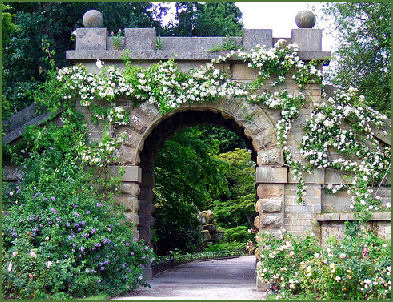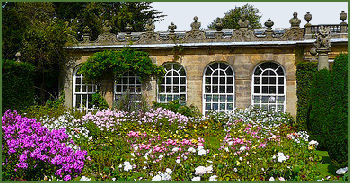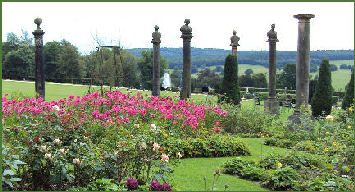Chatsworth Gardens
OS Grid ref:- SK463637
 Chatsworth House in the Derbyshire Peak District boasts a magnificent 105 acre garden which attracts around 300,000 visitors a year. It has a complex blend of different features from six different centuries and is superb in all seasons.
Chatsworth House in the Derbyshire Peak District boasts a magnificent 105 acre garden which attracts around 300,000 visitors a year. It has a complex blend of different features from six different centuries and is superb in all seasons.
The famous Capability Brown designed much of the landscape we see today at Chatsworth, he straightened the river, filled in most of the fishponds and extended the park to the west of the river.
In the nineeteenth century, a close partnership developed between the Sixth Duke of Devonshire and his gardener, Sir Joseph Paxton. They created a classic mixed style garden adjoining the house. Joseph Paxton carried out planting on an extensive scale.
The garden features five miles of walks with rare trees, shrubs, temples, sculptures, streams and ponds. The famous Chatsworth waterworks include the 300 year old Cascade, which descends 200 feet over a series of 24 steps, the willow tree fountain, the trough waterfall, and Revelation, a water-powered sculptural fountain designed by the sculptor Angela Conner and installed in 1999. In addition there is a large maze, and the rose, cottage and kitchen gardens, a stunning laburnum arch and sensory gardens, which are fully accessible to the disabled and feature many fragrant plants.
 The Emperor Fountain was constructed in 1844 to commemorate the visit of Tsar Nicholas I of Russia to Chatsworth and was built by William Cavendish, 6th Duke of Devonshire. The water jet is on record as reaching a height of 296 feet (90 metres) The fountain is situated at the north end of the Canal Pond, a rectangular lake measuring 314 yards long to the south of the house, which was dug in 1703.
The Emperor Fountain was constructed in 1844 to commemorate the visit of Tsar Nicholas I of Russia to Chatsworth and was built by William Cavendish, 6th Duke of Devonshire. The water jet is on record as reaching a height of 296 feet (90 metres) The fountain is situated at the north end of the Canal Pond, a rectangular lake measuring 314 yards long to the south of the house, which was dug in 1703.
The raised square garden known as Queen Mary's Bower, is the only part of the gardens to survive from the sixteenth century, it is associated with Mary Queen of Scots, who was said to have used the garden on top of the platform during her enforced visits to Chatsworth between the 1569 and 1581, when the Earl of Shrewsbury acted as her jailer. The bower was built in 1550's by the famous Bess of Hardwick and her husband as a viewing and fishing platform.
Late seventeenth century features include the Cascade which was designed by Grillet in 1696 and rebuilt on a grander scale in 1701. In 1703 a grand baroque Temple or Cascade House, designed by Thomas Archer was added at the top. The Sea Horse Fountain, designed by Caius Gabriel Cibber a sculptural fountain in a circular pond on the lawn between the house and the Canal Pond, the curious The Willow Tree Fountain is an imitation tree that squirts water on the unsuspecting from its branches and Flora's Temple, a classical temple constructed in 1695 and moved to its present site at the northern end of the broad walk in 1760. It contains a statue of the goddess Flora by Cibber.
 The Azalea Dell and the Ravine is situated at the southern end of the garden. This is the most rugged part of the garden with steep paths and a stream running down a small valley known as The Ravine. In 1997 a waterfall was created out of old drinking troughs gathered from fields on the estate. There is also a bamboo walk there. The Rockeries are the work of Paxton and contain the Wellington Rock which is 45 feet (14 metres) high with a waterfall which empties into a pond.
The Azalea Dell and the Ravine is situated at the southern end of the garden. This is the most rugged part of the garden with steep paths and a stream running down a small valley known as The Ravine. In 1997 a waterfall was created out of old drinking troughs gathered from fields on the estate. There is also a bamboo walk there. The Rockeries are the work of Paxton and contain the Wellington Rock which is 45 feet (14 metres) high with a waterfall which empties into a pond.
The charming Cottage Garden was inspired by an exhibit at the 1988 Chelsea Flower Show and consists of a front garden of flower beds bordered by box hedges which leads to a kitchen/dining room which has furniture covered with plants. There is also a bedroom in the same style on the upper level.
The Display Greenhouse was built in 1970 in a modern style. It has three climate zones, tropical, Mediterranean and temperate. Public access is limited but groups may book tours. The Kitchen Garden is a fruit and vegetable garden with decorative features. It was created behind the stables in the early 1990s.
The garden is managed by a team of 18 gardeners and trainees. At the same time as preserving its layers of history, new areas and features of the garden are being developed for visitors.
